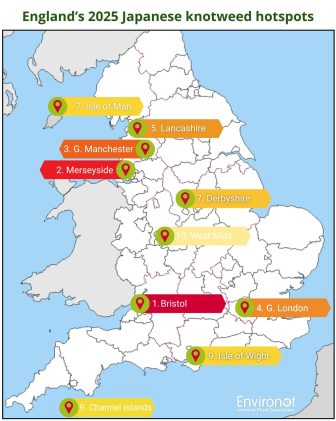Bristol has the highest concentration of Japanese knotweed in England, according to figures released by invasive plant specialist Environet.
The firm’s latest data shows Bristol recording 33.91 incidences of knotweed per square mile – well above any other region in the country.
Other areas with high concentrations include Merseyside (11.87 incidences per square mile), Greater London (7.74) and Lancashire (7.25).
The findings are based on over 100,000 verified sightings from the public, with data regularly updated through Environet’s online tracker.
The following locations were ranked according to incidences per square mile:
- Bristol (1,440 total incidences; 33.91 per mi²)
- Merseyside (2,963; 11.87 per mi²)
- Greater London (4,687; 7.74 per mi²)
- Lancashire (8,612; 7.25 per mi²)
- Greater Manchester (3,558; 7.22 per mi²)
- Isle of Man (982; 4.45 per mi²)
- Channel Islands (301; 3.94 per mi²)
- Isle of Wight (554; 3.77 per mi²)
- Derbyshire (3,427; 3.38 per mi²)
- Nottinghamshire (2,091; 2.51 per mi²)
Japanese knotweed, first introduced to the UK in the Victorian era, is now widespread, with an average of 1.1 occurrences in every square mile of England and 3.9 in Wales, according to Environet.
The invasive plant is known for its rapid growth, with underground rhizomes capable of reaching up to three metres deep and spreading up to seven metres horizontally. While serious structural damage is uncommon, its presence can reduce property values and lead to legal disputes between neighbours.
Emily Grant, director at Environet, said: “By mapping verified sightings, we’re helping people understand the level of risk in their local area and encouraging early identification and treatment.
“Vigilance is the best way to protect your property from Japanese knotweed, making sure you tackle it as early as possible before it becomes well established. At this time of year, knotweed is in full growth mode and easy to spot with its bright green heart-shaped leaves which grow in a zigzag pattern up the stems. Mature plants flower around August, when they produce clusters of tiny white blooms.
“Public engagement is key in the fight against knotweed, and by reporting new sightings property owners can play an important role in controlling this invasive plant and protecting property values.”
Read the orginal article: https://propertyindustryeye.com/environet-data-reveals-japanese-knotweed-hotspots/



